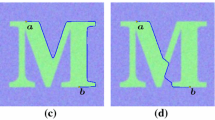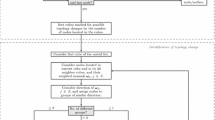Abstract
In this paper we consider a new approach for single object segmentation in 3D images. Our method improves the classical geodesic active surface model. It greatly simplifies the model initialization and naturally avoids local minima by incorporating user extra information into the segmentation process. The initialization procedure is reduced to introducing 3D curves into the image. These curves are supposed to belong to the surface to extract and thus, also constitute user given information. Hence, our model finds a surface that has these curves as boundary conditions and that minimizes the integral of a potential function that corresponds to the image features. Our goal is achieved by using globally minimal paths. We approximate the surface to extract by a discrete network of paths. Furthermore, an interpolation method is used to build a mesh or an implicit representation based on the information retrieved from the network of paths. Our paper describes a fast construction obtained by exploiting the Fast Marching algorithm and a fast analytical interpolation method. Moreover, a Level set method can be used to refine the segmentation when higher accuracy is required. The algorithm has been successfully applied to 3D medical images and synthetic images.
Similar content being viewed by others
References
Ardon, R. and Cohen, L. 2003. Fast constrained surface extraction by minimal paths. 2nd IEEE Workshop on Variational, Geometric and Level Set Methods in Computer Vision, pp. 233–244.
Bruckstein, A. 1988. On Shape from Shading. Computer Vision, Graphics, and Image Processing, 44(2):139–154.
Caselles, V., Kimmel, R., and Sapiro, G. 1997a. Geodesic active contours. International Journal of Computer Vision, 22(1):61–79.
Caselles, V., Kimmel, R., Sapiro, G., and Sbert, C. 1997b. Minimal-Surfaces based object segmentation. IEEE Transactions On Pattern Analysis and Machine Intelligence, 19(4):394–398.
Cohen, L. 1991. On active contour models and balloons. Computer Vision, Graphics, and Image Processing: Image Understanding, 53(2):211–218.
Cohen, L. 1997. Avoiding Local Minima for Deformable Curves in Image Analysis. In A. L. Mehaute, C. Rabut, and L. L. Schumaker (eds.), Curves and Surfaces with Applications in CAGD, Nashville.
Cohen, L. 2001. Multiple Contour Finding and Perceptual Grouping using Minimal Paths. Journal of Mathematical Imaging and Vision, 14(3).
Cohen, L. and Kimmel, R. 1997. Global Minimum for Active Contour Models: A Minimal Path approach. International Journal of Computer Vision, 24(1):57–78.
Cremers, D. and Schnörr, C. 2003. Statistical Shape Knowledge in Variational Motion Segmentation. Image and Vision Computing, 21(1):77–86.
Deschamps, T. and Cohen, L. 2001. Fast extraction of minimal paths in 3D images and applications to virtual endoscopy. Medical Image Analysis, 5(4).
Fritsch, F.N. and Carlson, R.E. 1980. Monotone Piecewise Cubic Interpolation. SIAM J. Numerical Analysis, 17:238–246.
Kass, M., Witkin, A., and Terzopoulos, D. 1988. Snakes: Active contour models. International Journal of Computer Vision, 1(4):321–331.
Osher, S. and Sethian, J. 1988. Fronts propagating with curvature dependent speed: Algorithms based on the Hamilton-Jacobi formulation. Journal of Computational Physics, 79:12–49.
Paragios, N. 2000. Geodesic Active Regions and Level Set Methods: Contributions and Applications in Artificial Vision. Ph.D. thesis, Université de Nice Sophia-Antipolis, France.
Sethian, J. 1996. A fast marching level set method for monotonically advancing fronts. Proceedings of the Natural Academy of Sciences, 93(4):1591–1595.
Sethian, J. 1999. Level set methods: Evolving Interfaces in Geometry, Fluid Mechanics, Computer Vision and Materials Sciences, University of California, Berkeley: Cambridge University Press, 2nd edition.
Tsai, A., Jr., A. Y., Wells, W., Tempany, C., Tucker, D., Fan, A., Grimson, W. E., and Willsky, A. 2003. A Shape-Based Approach to the Segmentation of Medical Imagery Using Level Sets. IEEE Transactions on Medical Imaging, 22(2):137–154.
Tsitsiklis, J.N. 1995. Efficient Algorithms for Globally Optimal Trajectories. IEEE Transactions on Automatic Control, 40(9):1528–1538.
Yuille, A., Hallinan, P., and Cohen, D. 1992. Feature Extraction from Faces using Deformable templates. International Journal of Computer Vision, 8(2):99–111.
Zhao, H., Osher, S. and Fedkiw, R. 2001. Fast surface reconstruction using the level set method. Workshop on Variational and Level Set Methods In Computerj Vision, pp. 194–201.
Author information
Authors and Affiliations
Corresponding author
Rights and permissions
About this article
Cite this article
Ardon, R., Cohen, L.D. Fast Constrained Surface Extraction by Minimal Paths. Int J Comput Vision 69, 127–136 (2006). https://doi.org/10.1007/s11263-006-6850-z
Received:
Revised:
Accepted:
Published:
Issue Date:
DOI: https://doi.org/10.1007/s11263-006-6850-z




